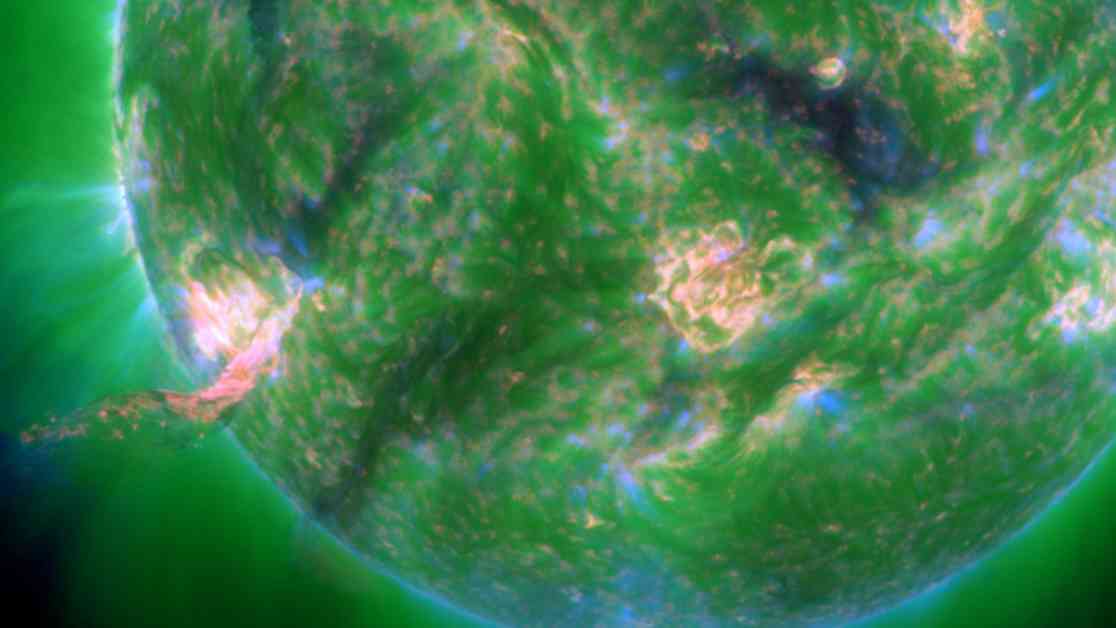The sunspot AR3834 erupted on Sunday, September 22, as captured by NASA’s Solar Dynamics Observatory. This eruption has raised concerns about the potential for Earth to experience a geomagnetic storm later in the week, particularly due to the timing of the solar outburst around the autumnal equinox.
The coronal mass ejection (CME) that occurred on Sunday at 5:39 p.m. EDT was unexpected, as the sunspot designated AR3835 had appeared stable prior to the eruption. Scientists were taken by surprise by the M-class solar flare that was unleashed, as reported by SpaceWeather.com. Traveling towards Earth at a speed of over 650,000 miles per hour, the solar plasma is projected to only have a glancing impact on Earth’s magnetosphere, with the majority of it missing the planet, according to NASA modeling.
While this type of event would not usually trigger a geomagnetic storm, the proximity of the CME to the autumnal equinox may increase the likelihood of such a phenomenon occurring on Wednesday, September 25. Geomagnetic storms have the potential to disrupt communication and power infrastructure, leading to blackouts in extreme cases. Additionally, these storms can produce stunning displays of auroras at high altitudes.
The NOAA Space Weather Prediction Center categorizes geomagnetic storms on a scale of G1 to G5, with the latter being the most severe and capable of causing widespread power and communication system failures. A G1 or G2 storm, like the one potentially expected on Wednesday, poses a slight risk of impacting infrastructure at high latitudes. The timing of this solar event, coinciding with the equinox, adds an element of uncertainty to the situation.
Equinoxes occur when Earth’s rotational axis aligns with its orbit around the sun, resulting in equal hours of daylight and night for both hemispheres. The autumnal equinox in 2024 took place on Sunday at 8:44 a.m. EDT, marking the official start of autumn for the northern hemisphere and spring for the southern hemisphere. This alignment of Earth and the sun during equinoxes can lead to an increase in geomagnetic storm frequency, as the magnetosphere and the sun’s magnetic field become aligned, unlike during the rest of the year.
The weeks surrounding the equinoxes are known to be prone to elevated geomagnetic storm activity, attributed to the Russell-McPherron effect. This phenomenon, proposed in 1973, explains the seasonal variation in geomagnetic storm frequency based on the alignment of Earth’s magnetic field with that of the sun. As a result, geomagnetic storms are more likely to occur around the equinoxes, while they are less common during the solstices when Earth’s poles are pointed away from the sun.
Data from 1932 to 2014 supports the seasonal distribution of geomagnetic storms, with a higher frequency observed around the equinoxes compared to the solstices. The relationship between Earth’s magnetic field orientation and solar activity plays a significant role in determining the likelihood of geomagnetic storms occurring. This interconnectedness underscores the importance of monitoring solar events and their potential impacts on Earth’s magnetosphere.
In conclusion, the recent solar eruption and its proximity to the autumnal equinox have raised concerns about the potential for a geomagnetic storm to impact Earth later in the week. While the exact effects of the coronal mass ejection remain uncertain, the alignment of Earth and the sun during equinoxes could elevate the risk of geomagnetic disturbances. Monitoring space weather and understanding the seasonal variations in geomagnetic storm frequency are essential in preparing for and mitigating the impacts of such events on Earth’s infrastructure and communication systems.













